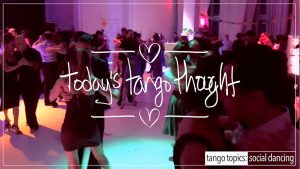(pron: Pro-Prio-Sep-Shun) According to Webster’s Dictionary the word ‘Proprioception’ comes from the latin word ‘proprius’ meaning “one’s own” or “individual”, and ‘capio’ or ‘capere’ meaning to take or to grasp. The word itself means a perception of one’s own body in space and time, as in the awareness of one’s body in space and time, as it refers to bodily position in space and time. The easiest way to define this gobblygook word is to say that it is to “sense something or someone without looking at it”, however it is much, much more than that. Muuuuuch more!
Tango Proprioception is a slightly different concept, and takes it’s cue from Proprioception and goes a step (no pun intended) further. Believe it or not we use it a fair amount of time when dancing whether or not we are aware of it or not. We use it to feel where we are in relation to our partners, but (and here’s where it takes on a life of it’s own) we also use to sense where our partners are in space (and time, very important for ‘timing’ of how and when things are done). This is quite factually using your partners body as an extension of your own to sense where things are around you! This is Tango Proprioception.
Further still we also use it to sense when our partner has completed a weight change or a they have taken a step. We use it in the embrace where we can clearly feel where something is but not see it. We use it as confirmation that we’re in the right place to execute our next movement. We use a piece of it to determine if we’re on beat (or not, and some of us have a problem with that) and we sense it when we’re not (again some of us have a problem with that part). There are many many practical applications for Tango Proprioception.
Make no mistake about this, it is a skill that takes time and practice (not patience) to develop. Further it must be developed with all due diligence, in much the same way that walking is developed. Why ? The simplest reason is that without it (as a Lead) you will constantly be looking down at your Follower’s feet thereby breaking the postural alignment of the couple! Thereby collapsing the couple in on itself (see “9 Lead No-No’s” – #8 specifically) As a Follower you’ll never be able to trust or rely on your abilities when being led into a series of Sacadas (including back sacadas) for fear of hitting your partner, or Paradas, or Pasadas, or Barridas, or even…the Forward step of your Molinete! A good number of Followers will quite factually open the embrace to watch themselves take a Forward step of the Molinete!
Both roles must feel where their partner is in space and time. This is not a Lead thing, nor is it solely a Follower thing that you tell the Follower to do, and they do it. NO! It’s a dancer thing! And so that we are clear here Tango Proprioceptionis not ‘feel’ as in emotion (uuuugh), but ‘feel’ as in tactile sensation! If you do not develop this skill, you are doomed (yes ‘doom’) to continue at your current method of less-than-desirable dancing, and you will constantly wonder why things don’t look the way that they should, most especially after you have spent oodles of money on classes with X or Y, or studied online courses (which don’t talk about the singular importance of this skill – mine do).
One has to ask the question, and it’s a perfectly valid one, is this really Proprioception or is it Exteroception ? It’s entirely Proprio! How’s that ? Exteroception is all about the environment that you find yourself in. Whereas that environment is acting on your body in space and time. Or you are responding to the stimuli of that environment. In this instance, and this is where you might rightfully claim that the descriptor above is about the stimuli of the environment, it is not. The descriptor above (Proprio) is talking about using your partner’s body as an extension of your own. Much like you can ‘feel’ a ring of keys hanging from your finger without seeing them. The environment (Extero) is that there is wind blowing and acting on the keys to swing, however in this case, the key ring itself (Proprio) is what we’re talking about. So ‘no’ dear reader, this is Proprioception and not Exteroception. 😉
So that we’re clear here, this is not about perfectionistic dancing, nor ego, nor arrogance. This is demonstrable fact. Have you ever wondered why certain dancers excel and others seemingly lag when both people started at the same time, under the same teacher, studying exactly the same material in exactly the same way ? There’s a reason for that. One might claim that it’s because people are different. True. But the material is exactly the same. One might argue, to a certain degree, that it’s because they have different body types, and they’re different ages. True to a certain degree. However, there are outliers to these arguments. So there must be another factor here (there are several actually) and Tango Proprioception is one of the key ones that if you fail to master it, you will fail at dancing. Yes you’ll be socially popular without it, but you’re not going to get the dances you want without it…continually! So it is in your best interest to develop this skill, asap. Just as a side note most of the videos on this site talk about Tango Proprioception in some way, shape, or form.











